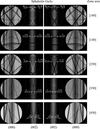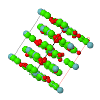issue contents
December 2013 issue

Cover illustration: Reduction of volumes of the voids in the crystal structures of DL-alanine and L-alanine on application of 6 GPa of pressure. Yellow voids are shown within the ball-and-stick structure models. The molecules as well as the topologies and symmetries of their packings are preserved over the whole pressure range of 0-6 GPa. See Fig. 4 in Tumanov & Boldyreva [(2012), Acta Cryst. B68, 412-423].
research papers
Download citation


Download citation


The temperatures of non-variant transformations in the tin-rich side of the Tb–Sn binary system were refined using differential scanning calorimetry. The crystal structure of βTb3Sn7 was determined for the first time from single-crystal diffraction data. The structures of α- and β-modifications were analysed and a possible mechanism of polymorphic transformation proposed.
The available data on the structural and magnetic transitions in hexagonal YMnO3 have been reviewed, making use of computer-aided symmetry analysis to list possible crystal and magnetic structures, and taking account of the capability of different methods to distinguish them. A favoured transformation sequence is presented.
Download citation


Download citation


The single crystal of the C2/c HT-CEn end-member is synthesized by rapid pressure–temperature quenching. It is suggested that the single crystal has been formed from the high-pressure clinoenstatite.
CCDC reference: 966424
Download citation


Download citation


The crystal structure of commensurately modulated Pr2SbO2 was solved in the orthorhombic superspace group Immm(0β0)000 from a crystal twinned by reticular pseudomerohedry. The formation of Zintl-type Sb2−–Sb2− dumbbells in Pr23+Sb2−O22− is considered to be responsible for its semiconducting properties.
The applicability of the structure-factor phase method in determining the polarity of binary semiconductors is investigated by dynamical simulations of convergent-beam electron diffraction. It was found that this method is efficient to determine the polarity of a sphalerite structure under certain conditions, and, reversely, limited to determine the polarity of a wurtzite structure.
A novel system of cationic radii for metals is proposed, based on the compressibilities of solids at ultra-high pressures.
Download citation


Download citation


The structure of kermesite, Sb2S2O, was refined and interpreted as an order–disorder (OD) structure of layers. The maximum-degree-of-order (MDO) polytypes are derived, twinning explained, and desymmetrization discussed and evaluated. The interpretation requires the use of a non-standard pseudo-monoclinic octuple unit cell with extra centering points. Its relation to the primitive triclinic cell is displayed in the picture.
Download citation


Download citation


The crystal structure of NaMnSO4F fluorosulfate compound has been solved, refined and compared with other alkali metal fluorosulfates and naturally occurring triplite-type minerals.
Twelve orientation domain variants in vacancy-ordered titanium monoxide TiOx and the crystallographic relationships among them were analyzed systematically by combining the group theory analysis and the electron diffraction technique.
Download citation


Download citation


The crystal structure of glycine silver nitrate (GSN) in a ferroelectric phase has been obtained by single-crystal neutron diffraction. It is suggested that the second-order Jahn–Teller behavior of the Ag ion in GSN leads to the structural phase change.
Download citation


Download citation


Polymeric alkali metal compounds with the simple formulae M(pyridonate)(solvent)n display some novel structural features, including bridging of two metal ions by the N atom of a pyridonate ligand and quadruple bridging by water molecules.
Download citation


Download citation


Analysis of the supramolecular interactions found in some dimeric tris(alkyl and/or aryldithiocarbamato)antimony(III) compounds.
CCDC reference: 968765
Download citation


Download citation


Experimental and theoretical electron densities of an oxaphosphinane derivative are presented. The existing intramolecular hydrogen bond is found to be an isolated hydrogen bond as opposed to a possible resonance-assisted hydrogen bond. P—O bonds are found to possess a high degree of ionicity.
CCDC reference: 964654
short communications
Open  access
access
 access
accessThe sequence of hexagonal ordered distributions of trivalent cations that are possible in the octahedral layer of layered double hydroxides is clarified, including the link between the composition and the supercell a parameter. A plausible explanation is provided for the observed variation in the lower solid-solution limit.


 journal menu
journal menu































